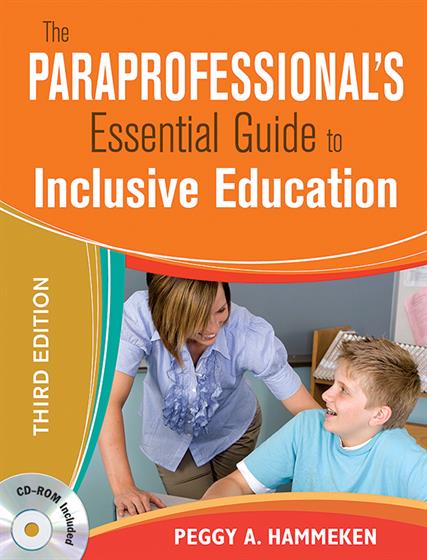Preface
Acknowledgments
About the Author
Introduction
1. Building Background
Activities
Inclusive Practices: Myth and Reality
Benefits of Inclusive Education
2. The Special Education System
Student Placement
What Are Handicapping Conditions?
Classroom Implications
Conclusion
3. The Special Education Team
4. Confidentiality and Special Education
Mandated Reporting
Confidentiality Related to Students
Activities
Guidelines for Confidentiality
5. Getting Started
Learning About Policies and Procedures
The Paraprofessional's Role
Role Delineation
Developing a Schedule
Scheduling for a Substitute
Effective Communication Strategies
Observations and Evaluations
Breakdown in Communication
Conclusion
6. The Paraprofessional and the General Education Teacher
Working in the Classroom Environment
Working With Students
Types of Classroom Instruction
Activity
Peer Tutoring and Leadership Opportunities
Skill Reinforcement
Assistive Technology
7. Accommodations and Modifications
What Is the Difference?
Levels of Change
Getting Organized
Frequently Asked Questions
8. Helping All Students Learn
Prereading Stage
Creating Audiotapes
Previewing or Preteaching Materials
On-the-Spot Changes
Novels, Free-Choice, and Silent Reading
Tracking Difficulties
Students With Hearing Impairments
Students With Vision Impairments
9. Support Across the Curriculum
Daily Assignments
Activities
Following Directions
Large-Group Instruction
Note-Taking Skills
Organizational Skills
10. Reading
Strategies for Struggling Readers
Reading Decoding
Reading Comprehension
Vocabulary Development
Students With Visual Difficulties
11. Written Language
Prewriting Stage
One Word at a Time
Generating Ideas
The Writing Process
Spelling in the Context of Written Language Assignments
12. Spelling
Grade-Level Spelling Lists
Parallel Spelling Activities
Drill and Practice Activities
Study Methods for Spelling
Spelling Tests
Grading
13. Mathematics
General Teaching Strategies
Parallel Math Activities
Modifying Math Assignments
Student Aids
14. Classroom Assessments
General Strategies
Types of Assessments
15. Behavior Management
Behavior Strategy Tips
Reinforcement and Discipline
ADD/ADHD
Providing Structure for Students
Working With Students
Working With Impulsive and Easily Distracted Students
A Final Note From the Author
Resources: Reproducible Forms
Form 1. Contact List
Form 2. Discussion Activities for Paraprofessionals
Form 3. Job Description
Form 4. General Responsibilities
Form 5. Roles and Responsibilities
Form 6. Daily Schedule
Form 7. Special Education Acronyms
Form 8. Daily Log
Form 9. Daily Communication
Form 10. Alternate Plan
Form 11. Medical Alert Form
Form 12. Classroom Information
Form 13. Goal Worksheet
Form 14. Instructional Changes
Form 15. Curriculum
Form 16. Textbooks
Form 17. Daily Assignments
Form 18. Assessments
Form 19. Volunteer List
Form 20. Daily Assignment Log
Form 21. Weekly Assignments
Form 22. Common Abbreviations for Note Taking
Form 23. Chapter Outline
Form 24. Compare and Contrast
Form 25. Weekly Study Schedule
Form 26. Priority Assignment Sheet
Form 27. My To-Do List
Form 28. Checklist: Materials to Take Home
Form 29. Alphabet Activities
Form 30. Alphabet Cards
Form 31. Common Word Families
Form 32. Basic Phonics Rules
Form 33. Dolch Word List
Form 34. Instant Words
Form 35. Bingo Game Grid
Form 36. Tic-Tac-Toe Grid
Form 37. Word List
Form 38. Story Organizer
Form 39. Common Prefixes and Suffixes
Form 40. Charting New Vocabulary
Form 41. Story Starters
Form 42. Story Planner
Form 43. Story Outline
Form 44. Proofreading Checklists
Form 45. Paragraph Sequencing Activity
Form 46. Study Methods for Spelling
Form 47. "What Do I Do if. . .?"
Form 48. Behavior Change Plan
Form 49. Tally Sheet
Form 50. Sample Reinforcement Charts
Form 51. Positive Reinforcement Phrases
Form 52. Point Sheet
Glossary
References
Index



